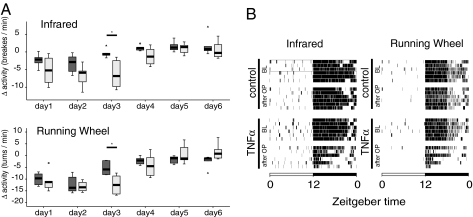Fig. 5.
TNF-α reduces locomotor activity of mice but does not alter their circadian rest-activity cycles in free running conditions. (A) Reduced locomotor activities in mice with constant TNF-α infusions are detected from days 1–4. Boxplot showing the changes of locomotor activity for each day after minipump implantation (TNF-α, 1.5 μg/day, for 6 days) or saline as control, compared with the baseline (mean of 3 days immediately before the operation). The TNF-α-treated group is shown as light gray bars and the control group as dark gray bars; circles are outliers, and triangles are extreme values. Six mice per group were analyzed. Data show one experiment (ANOVA for repeated measures, followed by independent-sample t tests; *, P ≤ 0.05). The effect of TNF-α to impair locomotor activity was confirmed at day 3 in two independent experiments. (B) TNF-α reduces locomotor activity in the second half of the dark phase. Actograms (as measured by infrared and running wheel) show data from six individual mice before and after the minipump insertion. Each line represents one individual mouse per treatment, 1 day before the implantation of minipumps (baseline, BL) and 3 days after the operation (OP).

